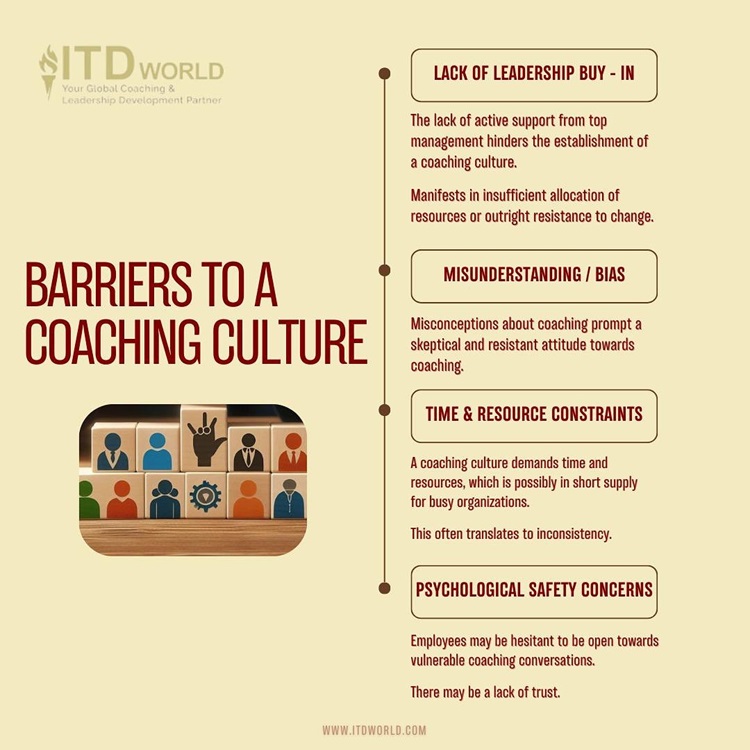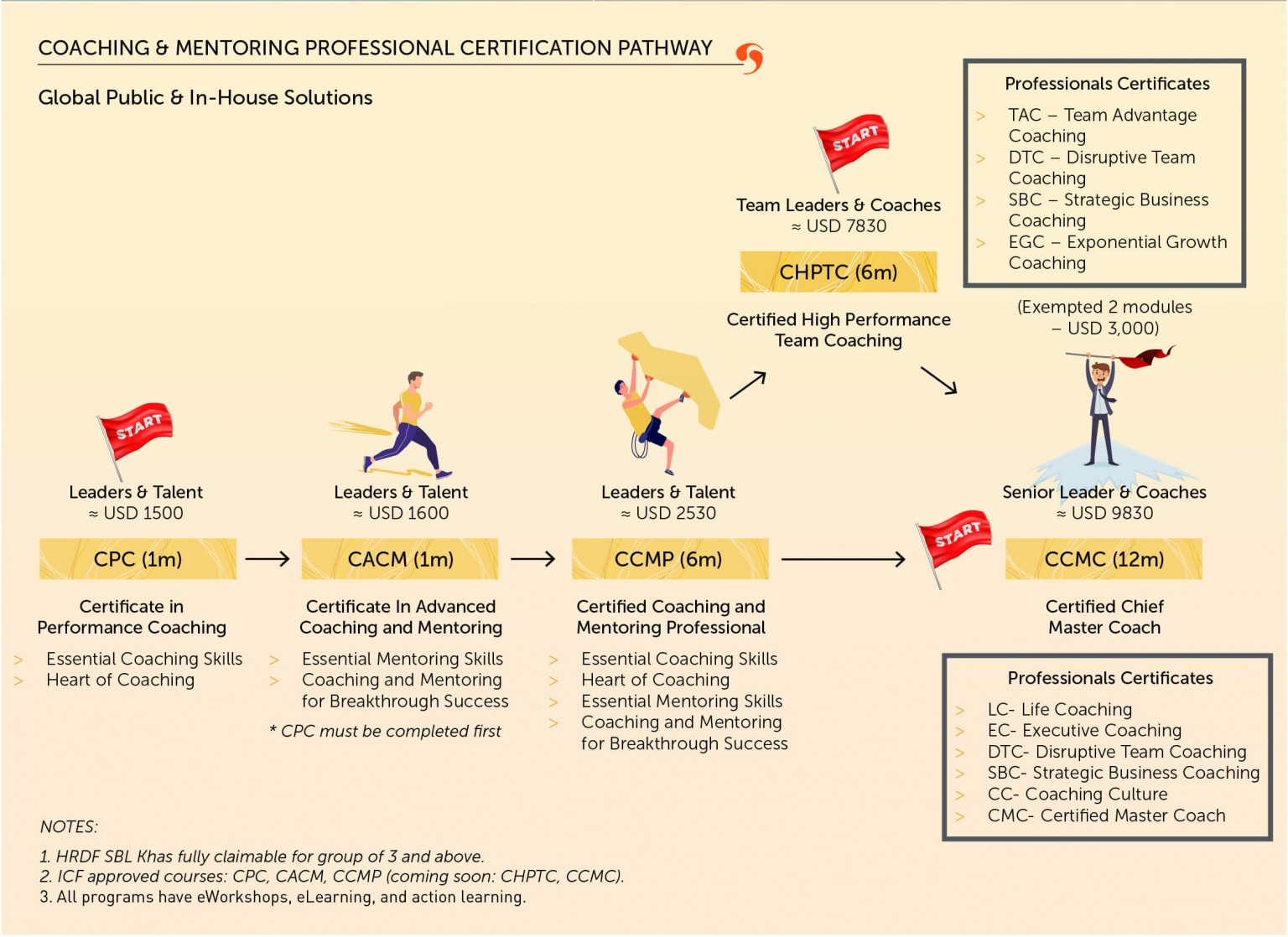Given the dynamic landscape of modern workplaces, coaching has been emerging as a pivotal force driving organizational success. Beyond a trend, building a coaching culture signifies a profound shift in how companies approach leadership, development, and collaboration within their teams.
(by Jonathan M. Pham)
What is a Coaching Culture?
A coaching culture is the manifestation of an organizational ethos wherein coaching becomes the cornerstone for employee development and support. In such an environment, the emphasis is not solely on managerial coaching – but extends to a collective responsibility where every individual, irrespective of their hierarchical position, actively contributes to fostering growth through continuous feedback, support mechanisms, and a commitment to learning.
At its core, coaching is a dynamic process that entails asking thought-provoking, open-ended questions, engaged listening, constructive feedback, and the cultivation of an atmosphere that encourages reflection and action. It provides a catalyst for employees to distill meaningful insights from their experiences, refine their skill sets, and successfully pursue their professional objectives.
The depth of a coaching culture surpasses the mere presence of managers coaching their subordinates. Instead, it permeates every facet of the workplace, becoming an integral part of the organization’s DNA. The principles of coaching are intricately woven into the daily fabric of interactions, shaping how colleagues collaborate, communicate, and collectively work towards shared goals.
Characteristics of a Coaching Culture
- Deeply embedded coaching mindset and culture: Coaching is not seen merely as a tool for problem-solving; rather, it is a valued and positive approach to learning and personal growth. This cultural integration extends across all levels and functions, aligning seamlessly with the organization’s overarching vision and values.
- Structured coaching processes: The presence of clear, well-defined processes and systems is another hallmark. Regular sessions, meticulous follow-ups, and systematic evaluations become ingrained practices. Additionally, tools and platforms are leveraged to facilitate effective communication and collaboration among team members.
- Leadership commitment: Leaders go beyond endorsing coaching in principle; they actively model coaching behaviors and throw their weight behind coaching initiatives.
- Emphasis on a growth mindset: In a coaching culture, a pervasive growth mindset permeates every level, from top leadership to team members. Challenges are considered growth opportunities – while learning and development become intrinsic values. As such, people are empowered to take ownership of their work, make informed decisions, and navigate challenges with the guidance of their coaches – thereby resulting in enhanced autonomy, creativity, and a sense of responsibility.
- Open communication and trust: Team members feel secure expressing their thoughts, concerns, and vulnerabilities without fear of judgment or reprisal. Regular, objective feedback is sought and encouraged as a means to propel individual and collective improvement.
- Collaborative and supportive environment: Collective endeavors are directed toward achieving shared goals, and individuals actively contribute to each other’s learning and development. Recognizing and celebrating achievements, regardless of size, becomes a norm. This celebratory culture reinforces positive behaviors, motivating team members to persist in their growth and learning journeys.

Why is a Coaching Culture Important?
For individuals
- Improved productivity
A coaching culture serves as a catalyst for individual growth, providing personalized guidance and feedback that fosters clarity in goal-setting and ownership of development. This, in turn, translates into improved task performance, enhanced problem-solving skills, and the delivery of high-quality work.
Case studies:
A multinational company, Organization X, conducted a two-month coach-training pilot for a select group of managers. The pilot demonstrated positive outcomes, including enhanced communication, feedback, trust, performance, and job satisfaction. These results led to the expansion of the workplace coaching curriculum across the organization.
On the other hand, a compilation of case studies from multiple companies – including Barclaycard Business, BEA Systems, Cobbetts, Deloitte, the VSO, and West Bromwich Building Society – also corroborated the positive impact of embedding coaching into an organization’s culture.
- Enhanced engagement and motivation
Fostering a coaching culture nurtures a sense of purpose and belonging among team members. As employees feel valued and supported in their personal and professional growth, they become more engaged, motivated, and committed to contributing to the success of the company.
- Better well-being and resilience
The open communication and supportive environment cultivated by a coaching culture contribute to stress reduction, the development of emotional intelligence, and the enhancement of coping mechanisms. This, in turn, promotes well-being and resilience among individuals.
- Adaptability and career advancement
Continuous learning within such a culture allows people to develop the skills necessary to adapt to change. This adaptability fortifies their resilience – as well as opens doors to career advancement and broader opportunities within the organization.
For teams
- Strengthened collaboration and innovation
A coaching culture enhances team dynamics by promoting effective communication, positive support, and clearer collaboration. As a result, team members are encouraged to explore new ideas, experiment with diverse approaches, and learn from varied perspectives – which helps stimulate creativity and innovation.
- Improved conflict resolution
Open communication, coupled with an understanding of diverse perspectives, facilitates constructive conflict resolution within teams. This not only builds trust but also strengthens relationships among members.
For organizations
- Improved talent retention and attraction
A coaching culture contributes to higher employee satisfaction and well-being, reducing turnover and absenteeism. Moreover, it becomes a compelling factor for attracting talented individuals seeking a workplace that is supportive and development-oriented.
Read more: Talent Management – Mastering the Basics for Success
- Enhanced overall performance
A study conducted by the Human Capital Institute and the International Coaching Federation (ICF) underscores the transformative impact of a coaching culture on organizational performance. Specifically, the presence of one makes a company more than twice as likely to be classified as a high-performing organization.
- Facilitate change
According to the Society for Human Resource Management (SHRM), coaching plays a pivotal role in facilitating individual behavior changes – either through the influence of external coaches or managerial involvement. This adaptability is crucial in navigating and embracing organizational change.
- Positive work environment
Coaching contributes to a positive and inclusive work environment, where individuals feel heard, supported, and encouraged to thrive both personally and professionally.
- Enhanced learning and development
One final benefit is the establishment of an ecosystem that fosters continuous learning and improvement. Within that environment, employees actively seek and share feedback, learn from mistakes, and embrace new challenges – all of which contribute to their overall growth.
The goal of coaching is the goal of good management: to make the most of an organization’s valuable resources.
Harvard Business Review
Examples of Companies That Have Succeeded in Establishing a Coaching Culture
Renowned for its innovative and collaborative ethos, Google has successfully embedded a coaching culture as a driving force behind its dynamic environment. The company extends coaching opportunities to all employees, ranging from new hires to senior leaders. Various diverse formats are utilized – such as one-on-one sessions, peer coaching, group coaching, and online coaching.
Managers at Google undergo training in the GROW framework (Goal, Reality, Options, Will) to solidify their role as effective coaches. Google’s policies contribute significantly to employee development, fostering creative problem-solving and effective teamwork.
- Microsoft
Microsoft, a tech giant with a global footprint, has strategically embraced coaching as a cornerstone of its transformation and growth initiatives. The company invests in building a robust coaching culture, providing coaching services across all organizational levels through various channels, including internal and external coaches and coaching platforms.
Microsoft promotes a culture of mutual coaching among employees, leveraging tools like CoachBot to deliver personalized feedback and guidance. This commitment aligns with the organization’s mission to empower individuals and organizations globally.
- Netflix
Netflix, a trailblazer in the entertainment industry, has disrupted norms with its original content and unique company culture. Coaching at Netflix reinforces its core values of freedom, responsibility, and context. The company uses coaching as a tool for regular and candid feedback, challenging employees to grow and empowering them to make decisions and take risks.
Leadership at Netflix is expected to embody coaching principles, inspiring and influencing teams while fostering a culture of curiosity and continuous learning.
- Spotify
Spotify, a global leader in music streaming, has crafted a dynamic and agile culture that aligns with its autonomous and cross-functional team structure. Coaching is integral to Spotify’s approach, facilitating effective collaboration, rapid experimentation, and continuous learning.
The company offers coaching through various avenues, including internal and external coaches, peer coaching, and even self-coaching. Leaders at Spotify are trained to be coaches, playing a pivotal role in guiding teams, fostering a culture of feedback, and promoting continuous improvement.
Read more: Organization Development (OD) – A Closer Look

Pillars of Coaching Culture
Below are some key ingredients that underpin the success of a coaching culture:
- Consciousness: Consciousness involves heightened awareness and mindfulness within the organization – where people are attuned to the impact of their actions, words, and decisions on themselves and others. As such, it fosters a culture where every interaction is intentional and contributes positively to the growth and development of individuals and the organization as a whole.
- Self-belief: Within a coaching environment, employees are encouraged to recognize their strengths, acknowledge their areas for improvement, and cultivate a sense of self-efficacy. This pillar empowers people to set ambitious goals, take risks, and persist in the face of challenges.
- Trust & respect: Team members feel secure in expressing their thoughts, ideas, and concerns, knowing that they will be received with respect. The result is a workplace setting where open communication thrives – and constructive dialogue/ exchange of ideas is promoted.
- Collaboration: In a coaching culture, teams are encouraged to work together, leveraging diverse skills and perspectives. This collaborative spirit extends beyond traditional hierarchical structures, promoting a sense of unity and shared responsibility.
- Empowerment & autonomy: Team members are provided with the tools, resources, and support needed to take ownership of their work and make informed decisions. Being guided by a clear framework allows for the cultivation of a sense of responsibility and accountability among employees.
- Psychological safety: People are free to be themselves – they feel comfortable taking risks, expressing innovative ideas, and admitting mistakes without fear of retribution.
- Equality & diversity: This pillar extends beyond demographic considerations to include a variety of skills, thoughts, opinions, and approaches. In a coaching culture, organizations actively seek and celebrate such diversity, recognizing its role in driving innovation and creativity.
- Blame-free environment: Individuals take responsibility for their actions and outcomes instead of playing the “blame game”. Mistakes are regularly reflected on for improvement.
- Coaching-focused leaders: At the core of a coaching culture are leaders who actively champion a coaching mindset. They invest in the development of their teams, provide constructive feedback, and create an environment where coaching is seen as integral to individual and collective success.
Barriers to Establishing a Coaching Culture
- Lack of leadership buy-in
The lack of active support from leadership is the first obstacle that potentially hinders the establishment of a coaching culture. This may manifest as mere lip service, insufficient allocation of resources, or outright resistance to the adoption of coaching practices.
Solutions:
Leading by example is crucial in overcoming this barrier. Organizations should start by equipping leaders with the necessary skills and knowledge to be effective coaches. They should articulate the positive impact of a coaching culture on individuals, teams, and the overall organization, aligning it with strategic goals.
- Misunderstanding/ Bias
Misconceptions about coaching (e.g. viewing it as remedial or exclusively for poor performers) are what prompt many people to adopt a skeptical and resistant attitude.
Solutions:
Clear communication is key to dispelling such assumptions. Organizations should educate employees on what coaching truly entails, emphasizing its benefits and distinguishing it from performance management. Positive examples of how coaching has contributed to individual and team success should serve as powerful testimonials. Reinforce that coaching is inclusive, and designed to support everyone’s growth.
- Time and resource constraints
The implementation of a coaching culture demands time and resources, which may be in short supply in busy organizations. This constraint often results in inconsistent implementation and a lack of sustained follow-through.
Solutions:
Consider starting small with pilot coaching programs for select groups before scaling up. Utilizing online coaching platforms and tools is a good idea to streamline the process and enhance accessibility. Additionally, encouraging peer coaching among employees helps distribute the coaching load, alleviating the burden on managers and leaders.
- Psychological safety concerns
Employees may hesitate to engage in open and vulnerable coaching conversations if there are concerns about psychological safety and trust.
Solutions:
Fostering a culture of open communication and transparency is foundational to addressing this issue. Build trust by establishing clear ground rules for coaching conversations, including confidentiality and respect. On top of that, organizations must equip coaches with skills to create a supportive and safe environment for coachees.
Read more: Performance Coaching Explained – Unlock People’s Greatness

How to Create a Coaching Culture at Work – A 4-step Framework
Step 1: Laying the foundation
- Define goals and alignment
Clearly articulate the goals of coaching within the organization. Define the benefits and outcomes you aim to achieve – making sure that they align with the overarching vision, mission, and values. Establish metrics to measure the impact of coaching, providing a tangible framework for evaluation.
Example:
– Goal: To enhance employee engagement and productivity by fostering a growth mindset and promoting continuous learning. This goal aligns with the organization’s vision of becoming a learning organization that empowers its employees to reach their full potential.
– Metrics: Employee satisfaction, engagement scores, and performance metrics.
- Craft a vision
Develop a vision for your initiative, including the values that will underpin it. Envision the workplace atmosphere you want to create – and how coaching principles will contribute to achieving broader organizational goals.
Example: Your vision might be to build up a supportive and growth-oriented environment that values empowerment, collaboration, and continuous learning. In that dream workplace, employees feel encouraged to ask questions, share ideas, and take risks. Coaching helps employees develop their skills, enhance their problem-solving abilities, and make better decisions, ultimately leading to improved organizational performance.
- Secure support from organizational leaders
Leaders should not only endorse the value of coaching; they need to actively engage in coaching practices themselves. This involves understanding, practicing, and advocating coaching skills within their teams.
- Communicate to employees
Transparently communicate the vision and benefits of the coaching culture to all employees. Clearly explain how they can participate and what it means for their individual development – so as to foster a sense of inclusivity and shared purpose.
- Invest in training and development
The next step is to equip leaders and managers with coaching skills through comprehensive training programs or workshops. Ensure that they are well-prepared to champion and embody coaching principles in their daily interactions.
Step 2: Building the structure
- Align coaching and performance goals
Integrate coaching goals with broader performance objectives. Utilize coaching conversations to support individual development and address performance gaps, reinforcing a holistic approach to employee growth.
Example:
One company aims to improve customer satisfaction by 10% within the next year. To achieve this goal, the management comes up with coaching goals for their customer service representatives (CSRs) that align with specific performance metrics:
| Coaching Goal | Performance Metric |
Broader Objective
|
| Resolve customer issues within the first contact | First contact resolution rate (FCR) |
Improve customer satisfaction
|
| Handle customer complaints effectively | Customer complaint resolution rate (CCR) |
Reduce customer churn
|
| Provide personalized customer experiences | Net promoter score (NPS) |
Enhance customer loyalty
|
This approach ensures that coaching initiatives are not siloed activities but rather integral components of the organization’s performance management system.
- Establish a learning framework
This involves setting clear expectations, providing ample training opportunities, and fostering a culture that values continuous feedback.
Example:
A marketing department establishes the following expectations for its coaching program:
| Purpose |
To enhance the skills and performance of marketing professionals, leading to improved marketing campaigns and increased customer engagement
|
| Goals |
To increase the effectiveness of marketing campaigns by 15%, boost customer engagement by 20%, and reduce marketing costs by 10% within one year
|
| Desired outcomes |
Participants will demonstrate improved communication skills, stronger problem-solving abilities, and a greater understanding of marketing principles
|
Based on this foundation, various training programs are held to cover a range of areas, including active listening, questioning techniques, and feedback delivery – all of which contribute to the visualization of the defined goals. The programs are conducted in a variety of formats – including online modules to equip foundational knowledge, hands-on workshops that involve role-playing scenarios to apply what has been learned, etc.
- Conduct mentorship and peer coaching
Introduce formal or informal mentorship and peer coaching programs to create ongoing learning and support networks. These programs contribute to a collaborative environment where knowledge is shared and skills are honed collectively.
- Establish feedback mechanisms
Develop channels for regular feedback on the coaching culture and individual progress. Utilize surveys, focus groups, and ongoing coaching conversations to gather insights and gauge the effectiveness of the initiatives.
Step 3: Fostering the environment
- Encourage ownership and decision-making
Cultivate an environment where employees are encouraged to take ownership of their development and decision-making. Provide support and guidance while encouraging experimentation and learning from experiences.
- Promote knowledge sharing
Create platforms and spaces for peer-to-peer coaching, mentoring, and learning communities where team members can share expertise, insights, and best practices. For instance, consider building up an online forum, where team members can post articles, share documents, and engage in discussions. Organizing regular knowledge-sharing events (e.g. brown-bag lunches, workshops, or online seminars) where team members can present their expertise on a particular topic is also a great idea.
- Celebrate shared successes
Acknowledge and celebrate achievements, both big and small, to reinforce positive behaviors and motivate continuous learning. Recognition serves as a powerful reinforcement mechanism within a coaching culture.
Step 4: Continuous improvement
- Evaluate and iterate
Regularly assess the effectiveness of the coaching culture through data analysis, feedback mechanisms, and focus groups. Identify areas for improvement and adapt the approach accordingly, ensuring a dynamic and responsive coaching framework.
Example:
A technology company conducts a series of focus groups with employees to gather feedback on their experience with the coaching program. The feedback reveals that employees value the initiative – however, they feel that the sessions are not held frequently enough yet.
Based on this result, the company decides to increase the frequency of coaching sessions for all employees. This change is implemented to provide team members with more opportunities to receive personalized guidance and support – which is expected to lead to improved performance and greater satisfaction.
- Share success stories
Make it a priority to share success stories and positive outcomes of coaching within the organization. These anecdotes serve as powerful motivators, inspiring others and sustaining momentum.
- Secure leadership reinforcement
Continuously engage leadership in championing the coaching culture. Their ongoing support and active participation remain crucial for the long-term success and sustainability of the coaching framework.
Best Practices for Establishing & Maintaining a Coaching Culture
- Utilize various types of coaching: Explore diverse coaching methodologies to enrich the coaching culture. For instance, organizations may consider incorporating executive coaching for leadership development, peer coaching for collaboration, and team coaching for collective growth and shared learning experiences. Tailor the approach to meet the unique needs and dynamics of different organizational levels.
- Pay attention to inclusivity: Ensure that coaching opportunities are accessible to employees from diverse backgrounds – and at all hierarchical levels. Implement inclusive practices that consider individual needs, fostering an environment where everyone feels valued and supported in their development journey.
- Make use of technology: Given the current digitalization trend, organizations must learn to utilize coaching platforms, apps, and virtual tools to facilitate seamless communication. For example, ITD World’s 360-degree leadership e-assessment solution is a great tool for self-evaluation and ensuring high performance. Leverage technology to overcome geographical barriers and provide continuous support to individuals and teams.
- Integrate with performance management: Demonstrate how coaching can be seamlessly integrated into goal setting, performance improvement, and feedback mechanisms. Showcase instances where it contributes to individual and organizational performance enhancement.
- Take global perspectives into account: Cultural variations may influence the adoption and success of coaching initiatives. As such, organizations should be aware of the need for cultural sensitivity and tailored approaches to ensure their practices align with diverse workplace contexts.
- Think for the long term: Periodic assessments are crucial to gauge the effectiveness of coaching initiatives and make necessary adjustments.

The Role of Leaders in Cultivating A Strong Coaching Culture
Leaders are not merely participants – they are architects and catalysts in the creation of a robust coaching culture. Their role is to shape the environment – by infusing it with principles that promote growth, open communication, and continuous learning. Here’s how they can effectively contribute to the foundation of such a workplace culture:
- Be a role model
Leaders need to actively engage in coaching conversations with their teams. They are encouraged to embody the principles of coaching – by asking open-ended questions, practicing active listening, and providing constructive feedback. Through their actions, leaders showcase the practical application and value of coaching in personal and professional development.
- Champion the culture
This involves providing resources and support for the development of coaching skills among employees. By championing coaching initiatives, leaders signal the importance of continuous improvement and individual growth within the organizational ethos.
- Build trust
Trust forms the bedrock of a coaching culture. As such, leaders are called to demonstrate a genuine interest in their employees’ goals and challenges, so as to create an environment where people feel comfortable sharing and seeking guidance.
- Tailor their approach
Effective leaders recognize the importance of tailoring support based on the needs and readiness of their employees. They understand that a one-size-fits-all approach to coaching may not be effective – as such, they are willing to adapt their style to meet the unique requirements of each team member.
Read more: Situational Coaching Model (SCM) for Breakthrough Success
- Value the learning process
Leaders must instill a value for the discovery and learning process within the coaching culture. They should encourage employees to experiment, reflect, and learn from both mistakes and successes.
Tips for leaders:
- Start small: Leaders are encouraged to initiate change incrementally. Starting with pilot programs or small-scale initiatives allows for testing and gathering feedback before scaling up. This approach minimizes resistance and ensures a smoother transition into a coaching culture.
- Seek feedback and adapt: Remaining open to adapting strategies based on insights and evolving needs demonstrates a commitment to continuous improvement and responsiveness to the team’s dynamics.
- Focus on relationships: A foundation of positive relationships enhances the receptiveness to coaching principles.
- Make it fun: Leaders should inject humor and playfulness into all coaching interactions. Creating a positive and engaging environment fosters trust, connection, and a sense of ease in embracing coaching practices.
People don’t mind being challenged to do better if they know the request is coming from a caring heart.
Ken Blanchard
How to Measure the Impact of a Coaching Culture
Individual level:
- Engagement and motivation: Conduct surveys to gauge employee engagement, job satisfaction, and motivation. Track absenteeism and turnover rates as indicators of employee commitment – and analyze performance reviews for signs of increased engagement, initiative, and proactive contributions.
- Development and growth: Implement pre- and post-coaching assessments to measure skill enhancement, knowledge acquisition, and self-efficacy. Track participation in training and development opportunities to assess the impact of coaching on continuous learning.
- Well-being and resilience: Use surveys to measure stress levels, emotional intelligence, and overall well-being. Track conflict resolution rates and employee satisfaction with conflict management processes. In addition, analyze absenteeism and healthcare utilization data to identify improvements in well-being linked to coaching.
Team level:
- Collaboration and communication: Conduct surveys to evaluate teamwork, communication effectiveness, and trust within teams. Observe team meetings and collaborative projects to assess communication dynamics influenced by coaching. And finally, track team performance metrics and identify areas where coaching has contributed to improved collaboration.
- Innovation and creativity: Measure the number of new ideas generated and implemented within teams. Surveys may be administered to gather insights into employees’ ability to express creativity and take risks. Track successful innovations and attribute them to behavior changes inspired by coaching.
Organizational level:
- Financial performance: Key financial metrics like revenue, profitability, and customer satisfaction should be tracked – both before and after implementing the coaching culture. Based on that, attribute improvements in financial performance to increased employee engagement and productivity fostered by coaching.
- Talent acquisition and retention: Analyze recruitment results and employee retention rates to determine if they improve with a strong coaching culture. In addition, conduct surveys to understand candidate and employee perceptions of the coaching culture as a motivator for talent acquisition and retention.
- Employer branding and reputation: Track social media engagement and collect employee testimonials about the company’s coaching culture. Measure industry awards and recognition related to talent development and employee engagement.
Under all circumstances, organizations should always strive to adopt a multi-level approach – by utilizing metrics across individual, team, and organizational levels – in order to gain a comprehensive understanding of the impact of the coaching culture. Aside, make sure to combine quantitative data from surveys and performance metrics with qualitative insights obtained through interviews and focus groups – so as to produce a well-rounded assessment of the coaching culture’s impact.

Coaching Culture Resources
Books
- “Building and Sustaining a Coaching Culture” by David Clutterbuck, David Megginson, and Agnieszka Bajer: A fully revised version of “Making Coaching Work,” this book delves into the changes in the coaching culture field. It provides updates on new knowledge and experience, offering international case studies and practical tools. The book guides readers in developing and implementing a successful and integrated coaching culture.
- “The Coaching Effect: What Great Leaders Do to Increase Sales, Enhance Performance, and Sustain Growth” by Bill Eckstrom and Sarah Wirth: Based on extensive research, this book identifies common characteristics and behaviors of great coaches. It offers a four-step process to guide leadership development, showing how to create a coaching culture that fosters trust, collaboration, and accountability within organizations.
- “Coach Culture: A Playbook for Winning in Business” by Shawna Corden: Exploring the factors that contribute to a productive and engaged workforce, Corden’s work provides insights on creating a coach culture. It guides organizations in shifting their teams to become inspired, innovative, and connected individuals who maximize their strengths and contribute to the mission and purpose of the organization.
- “Creating a Coaching Culture” by Peter Hawkins: A comprehensive resource answering common questions about coaching culture, including creation, benefits, outcomes, performance linkage, measurement of return on investment, and sustainability. The book includes case studies, examples, and frameworks to assist in implementing a coaching culture within organizations.
Read more: 20 Best Coaching Books to Level Up Your Life
Podcasts
- “The Coaching Culture Podcast“: Offers practical strategies, implementable ideas, and real conversations around coaching. The podcast features discussions with experts in culture, leadership, and psychology, delivering short and digestible episodes approximately 30 minutes in length.
- “Building and Sustaining a Coaching Culture Podcast“: A podcast that analyzes changes in the coaching culture field, providing updates on new knowledge and experience. It offers international case studies and practical tools to help organizations develop and implement a successful and integrated coaching culture.
Read more: 55 Company Culture Quotes – Building a Great Workplace
Discover ITD World’s Coaching Culture Facilitator Courses
Ready to transform your organization from a workshop-driven environment to a thriving coaching culture? Look no further than ITD World’s coaching programs – designed to equip you with the tools and expertise to make it happen!
Our courses go beyond traditional training programs. They offer a comprehensive and immersive experience, equipping you with the knowledge, skills, and frameworks to:
- Understand the power of a coaching culture: Explore the benefits of coaching for individuals, teams, and the organization as a whole. Learn how it fosters engagement, boosts performance, and drives innovation.
- Master the art of coaching: Develop your coaching skills through practical exercises, simulations, and expert guidance. Learn how to build trust, ask powerful questions, provide constructive feedback, and empower others to reach their full potential.
- Design and implement a coaching culture: Understand the key elements of a thriving coaching culture and learn how to tailor it to your specific organizational context. Gain insights into building systems, structures, and processes that support continuous learning and development.
- Become a change champion: Develop your leadership skills to champion the coaching culture within your organization. Learn how to inspire others, navigate resistance, and build a sustainable culture of growth and collaboration.
Contact ITD World today for a FREE consultation!
FAQs
How can a coach cultivate a positive culture?
A coach can cultivate a positive culture by fostering an environment where individuals feel valued and empowered. This involves:
- Prioritize active listening without judgment.
- Encourage open communication and maintain confidentiality.
- Give and receive feedback constructively and respectfully.
- Support and stretch individuals’ thinking.
- Challenge with support to foster personal and professional growth.
- Focus on shifting mindset from fixed to growth.
- Encourage a shift from problem-oriented thinking to solution-oriented approaches.
- Engage in short but impactful development conversations.
- Model the values desired for the positive culture.
- Be humble and open to input from others.
How does ITD World build coaching into an organization’s culture?
At ITD World, we don’t just train via mandated sessions – we are dedicated to helping our clients embed coaching principles into how their people interact, how their teams collaborate, and how their leaders guide others. We take pride in our success stories with some of the most well-known organizations regionally and globally:
- ThaiBev: ThaiBev, a leading beverage company, partnered with us to build a coaching culture. Leaders received intensive coaching training, then cascaded the skills down, equipping everyone from managers to production staff. The result? Improved communication, stronger team dynamics, and increase in employee engagement.
- Aeon: Aeon Vietnam, another retail giant, saw similar results. We helped cultivate a coaching culture across all levels, promoting feedback, development, and ownership. The outcome? Stronger leadership, a more engaged workforce, and a significant improvement in customer satisfaction. Even better, they became the first organization in Vietnam to win the prestigious Marshall Goldsmith Coaching Culture Excellence Award.
Final Thoughts
Fostering a robust coaching culture is not merely an organizational strategy – it represents a fundamental mindset shift that propels continuous growth and innovation. As you embark on integrating the above-mentioned insights into your workplace, remember that establishing such a culture is a perpetual journey that requires a strong commitment to learning & development, plus an unwavering belief in the potential for greatness within everyone.
Other resources you might be interested in:
- Leadership Values: 10 Qualities for Exceptional Results
- Human Resource Management: Key Foundations
- Weak Leadership: How Bad Leaders Erode Success


